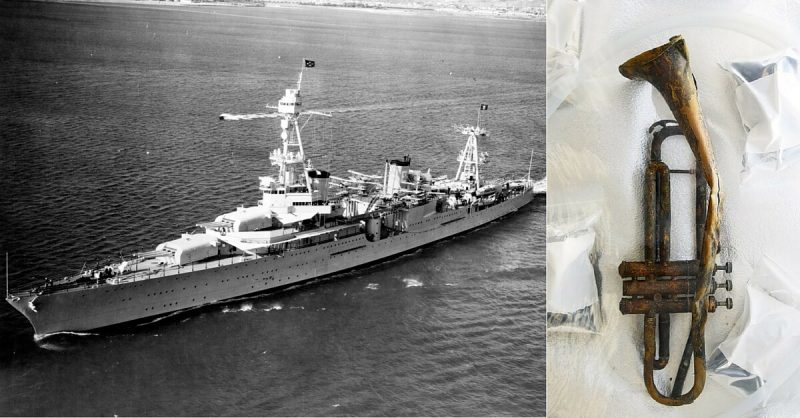It doesn’t look like the sort of object that might contain historical secrets, locked away inside. In fact, it looks more like something you could find in a garage sale, on sale for a few pennies.
However, according to senior Navy conservators at the Washington Navy Yard, it could become a major part of World War Two history. It’s a trumpet in the key of B-flat, manufactured in 1934. The trumpet’s bell is destroyed and its mouthpiece is gone. The body of the trumpet is covered in cracks and dents.
It was recovered from a sunken U.S. Navy ship that vanished beneath the waves during World War II. It appeared in the Navy Yard two and a half years ago after an Australian scuba diver found it in the wreckage of the USS Houston, a cruiser that sank off the coast of the island of Java in the South Pacific. The ship was President Franklin Roosevelt’s favorite Navy ship and served as the figurehead of the American Navy in the Pacific – a symbol of America’s sea power in the years between wars.
Yet the ship was sunk only three months after Pearl Harbor, when – along with an Australian vessel, the HMAS Perth – it accidentally sailed into the middle of a Japanese fleet, during the night. They were surrounded by enemy ships and bombarded from all sides.
The Houston lived up to the best traditions of the American navy, firing signal flares at the enemy when it ran out of shells for its guns. However, the two ships were hopelessly outnumbered and outgunned. Both vessels sank; first the Perth, then the Houston. They slipped below the water just a few minutes after midnight on March 1st. The year was 1942. Over 500 sailors perished beneath the waves. The rest of the crew, almost 300 sailors, finished the war in Japanese prison camps.
So why is this trumpet so important?
Robert S. Neyland, head of underwater archaeology at the Navy Heritage Command, believes that the scrapings taken from the trumpet could contain clues about its owner, if DNA evidence has survived on the surface or on the inside of the trumpet. It sounds like a long shot, but according to experts like Neyland, it’s not unheard of for DNA evidence to remain intact in similar situations.
Experts agree that finding the DNA evidence could be tricky – they’d have to locate a part of the trumpet undisturbed by corroding salt water, and then track down the descendants of the person who played the trumpet. Nonetheless, they agree that the prospect of being able to extract such specific evidence from this little piece of metal is very tantalizing, and certainly a possibility. The trumpet is also helping to keep alive the memory of the heroic crew of the USS Houston.
